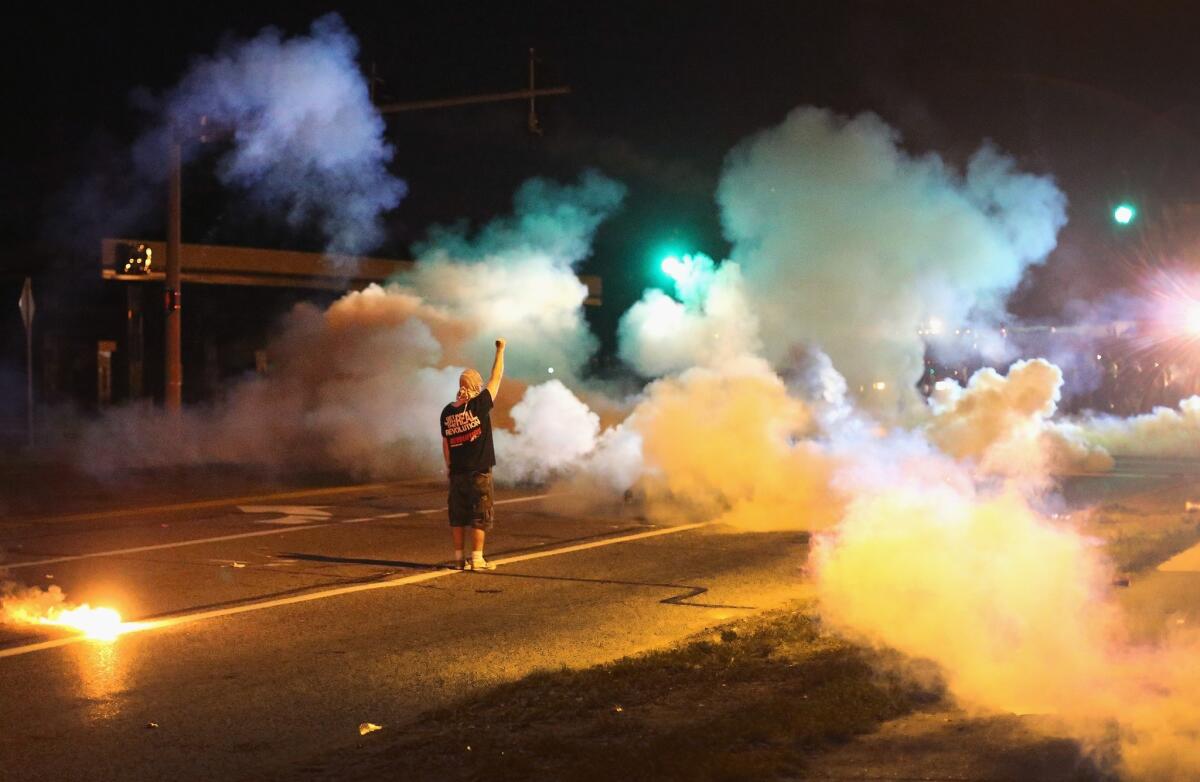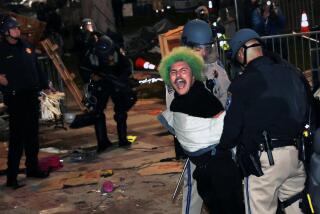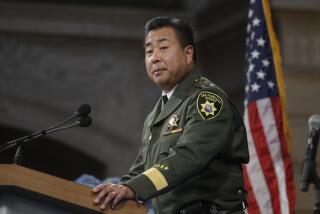Ferguson, Mo., police are using a blunt instrument -- tear gas

- Share via
The images have left a searing impression: Heavily armed police lobbing smoking tear gas canisters into the crowd of protesters.
The backlit plumes of smoke have appeared nearly every night, enforcing the picture of suburban Ferguson, Mo., as a battleground between black protesters and largely white police.
The use of the crowd control gas has inflamed the tension and exacerbated a sense among residents that police have taken an overly aggressive stance against protesters.
Riot control experts say that the use of tear gas can not only quell unrest, but also incite it if it is not used properly.
After a two month standoff in 1993, federal agents fired tear gas into a compound occupied by the Branch Dividians near Waco, Texas, triggering years of investigation of the resulting tragedy that took 76 lives.
Seattle police in 1999 fired so much tear gas into crowds of thousands who were protesting a World Trade Organization meeting on economic globalization that they ran short of canisters.
In 2003 in Chicago, 21 people died at a stampede in a nightclub after security guards used pepper spray on the dance floor.
Law enforcement agencies have continued to refine their policies and tactics in using tear gas or pepper spray, but have not retreated from their use, law enforcement officials and crowd control experts say.
The policies and tactics for tear gas use vary widely between departments, including dictating the kinds of situations that merit gassing groups of people and the level of leadership that can authorize its use.
“Police are not allowed to use tear gas on crowds; they can use it on mobs,” said Sid Heal, a former deputy sheriff in Los Angeles who is considered a top expert on nonlethal weapons.
Heal said there are two certainties when using pepper spray or tear gas: The police are certain to be videotaped and there will be a lawsuit afterward.
“The use of different launching platforms requires a lot of training and careful analysis,” said Edward Obayashi, a deputy sheriff and a use-of-force legal advisor to multiple law enforcement agencies in California.
Obayashi said such tactics can be complicated when unruly crowds require responses by multiple law enforcement agencies that can have different policies.
The use of all weapons in California are governed by the decisions of the U.S. 9th Circuit Court of Appeals and the U.S. Supreme Court, while other parts of the country may have different rules from their own federal circuit courts, he said.
Tear gas was first used more than a century ago, and ever since law enforcement agencies have been refining their policies for employing it.
In general, the police are reluctant to use tear gas, because it is such a blunt instrument, threatening innocent bystanders as well as perpetrators.
If a wind is blowing strongly or in the wrong direction, the use of tear gas can backfire.
It is particularly risky in dense urban areas, where highrise buildings can have their ventilation system intakes near street level. An entire building can be accidentally contaminated.
Use inside a building is especially problematic, since the gas can become embedded in fabrics, drapes and carpeting, causing recontamination weeks later, Heal noted.
With so much at stake, law enforcement agencies require varying degrees of senior officer approval for its use.
The Los Angeles Police Department, for example, requires approval of a senior officer in the command structure, Heal said. By contrast, the Los Angeles County Sheriff Department allows sergeants to issue an order to fire tear gas, he said.
The massive rioting that hit Seattle in 1999 took police by surprise and they resorted to extensive use of nonlethal weapons, particularly tear gas. An after-action report on the police response found no fault in the tactics.
“When presented with the need to reopen the downtown area and protect the rights of all people, SPD had two basic choices when those obstructing the area refused to obey a lawful police order to disperse: They could use batons, with the potential physical injury that they cause, or they could employ chemical irritants and other less lethal munitions,” the report said.
“The use of chemical irritants and other less lethal munitions allowed SPD to open the area, allowing Conference delegates to move among venues while avoiding serious injuries or fatalities. SPD did well to choose the latter course of action,” the report said.
Paul Wertheimer, a crowd control expert who runs Crowd Management Strategies, said the Occupy Movement in 2011 highlighted the wide variation in law enforcement responses.
While police in New York and Oakland fired tear gas at protesters, Los Angeles did not.
“I thought Los Angeles was a good example of crowd control without excessive force,” Wertheimer said.
Increasingly, protestors come prepared for the gas, carrying water, cloth, filters and even gas masks.
When police fire it into a crowd, it can exacerbate the very conditions that caused police to use it in the first place, stirring anger among people who might be bystanders and not instigators.
On the other hand, Wertheimer said, tear gas can also be a good choice. “It’s not the worst thing you can do to people,” he said.
More to Read
Sign up for Essential California
The most important California stories and recommendations in your inbox every morning.
You may occasionally receive promotional content from the Los Angeles Times.











